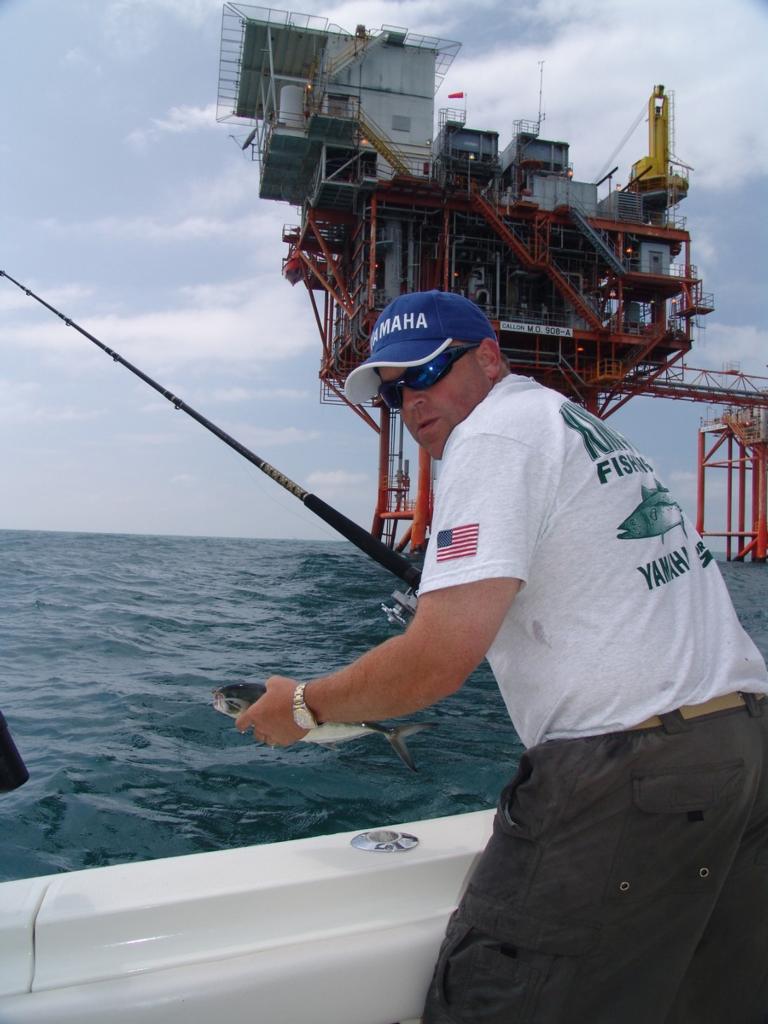Lock and load
Fresh, live baitfish ammunition for kingfish anglers

ORANGE BEACH, Ala. – About 20 miles to the west, tourists gawked at leopards, wallabies, macaws and monkeys roaming their enclosures within the Alabama Gulf Coast Zoo. Meanwhile, Capt. Bart Wetherington watched over a couple dozen blue runners swimming inside the bait pen floating next to his 33-foot Hydra-Sports docked at Phoenix on the Bay II condominiums in Orange Beach, Ala.
The chunky baitfish aren’t pets, and they’re not for display. In fact, Wetherington would prefer that no one else looked at his captives – no one but a kingfish big enough to win the Wal-Mart FLW Kingfish Series Championship, which begins Friday.
“Our first priority for tournament prefishing is to secure bait,” Wetherington said. “This gives us confidence that we can at least start the tournament with baits in our livewell.”
Wetherington and his teammates caught their baitfish Wednesday in preparation for the tournament’s commencement – originally set for today. Inclement weather canceled day one, so teams will now compete Friday with the top five advancing to Saturday’s finale. However, blue runners are hardy fish, so keeping them penned for a day and a half should be no problem.
Having won the Kingfish Series’ South Carolina-Georgia Division points title, Wetherington and his King of Kings2 teammates intend to use their blue runners to dethrone Kevin Alexander of Conroe, Texas, whose Team Force 10 won the 2006 Kingfish Series Championship. For all teams competing in this event, live baitfish will play a key role in their performance. Here’s a look at how kingfish tournament anglers handle their live baits.
Catch `em
In the Northern Gulf, blue runners (aka hardtails), cigar minnows and sardines are common kingfish baits. All can be found congregating around the legs of drilling rigs, and all readily bite sabiki rigs – strings of gold hooks dressed with fish skin quills and colorful fibers. With a lead weight tied to the bottom, a sabiki rig attracts baitfish when jiggled in the water column. The flashing hooks resemble tiny crustacean forage, and when baitfish bite, they become ensnared.
Sabiki sizes vary by bait size. Large blue runners will also snap at spoons and small diamond jigs cast or trolled around the rigs.
Some kingfish anglers may employ heavy cast nets for nabbing mullet and menhaden – both viable kingfish baits – but neither will bite sabiki rigs. Also, these baits don’t fare well in bait pens, so anglers who intend to use mullet or menhaden will catch them on tournament days.
Hold `em
Bait pens vary from ventilated plastic barrels to mesh enclosures built with securable lids. With ample water flow, baitfish remain fresh, and their enclosure is swept clean of waste and debris. When it’s time to go fishing, anglers simply open the lid and transfer baits into their boat’s livewell.
Positioning matters much, as you don’t want your pen squeezed between an adjacent boat or dock piling when tides or weather push objects around. When spacing allows, securing a bait pen between the dock and your boat’s stern affords optimal reach, but tying the pen off your bow minimizes unauthorized access.
Although pens are usually seen floating, Wetherington’s teammate Mike Simko of Jupiter, Fla., likes to remove the floats and sink the pen whenever marina depth allows. “Most of your contaminants like gas and oil are floating at the surface, so getting those baits deep is a good idea.”
Rig `em
Kingfish anglers will deploy their live baits on stinger rigs. Designed to eliminate “short strikes” in which a kingfish nabs half of a bait and misses a single nose hook, this rig comprises a lead hook set through the bait’s snout and a trailing treble “stinger” hook connected by a wire segment.
Hook and wire size varies with personal preference, but a basic setup includes No. 4 wire leader, a 2/0 lead hook, No. 5 wire stinger segment and No. 4 treble hook. Six to 10 feet of 20-pound fluorocarbon leader decreases visibility and adds a shock absorber between the main line and the wire terminal tackle. For larger baits such as jumbo blue runners, ladyfish or bluefish, rigging additional stinger segments ensures total coverage.
In conditions of low visibility, colorful skirts called “dusters” will enhance a bait’s chances of attracting kingfish attention. White, pink and chartreuse – plain or with Mylar fibers – are productive colors.
Flashy spinner blades rigged on wire leaders also catch the watchful eyes of hunting kings. Sound helps too, so anglers often employ enhancements like the Turbo Rattler – a plastic chamber containing lead beads. Oncoming water hits the device’s fins, causing the chamber to spin and rattle the beads.
Anglers often complement their live offerings with dead ribbonfish. Typically run deep on downriggers, the long, slender baitfish presents a large silver target that attracts big kings and intimidates smaller fish. Ribbonfish rigs start with a 1/4-ounce jig set bottom-to-top through the jaws and multiple stinger segments spaced about 4 inches apart.
Ribbonfish are brined and frozen shortly after capture, so they’re easy to transport in coolers. Live baits require much more care and concern, but when big kings are looking to satisfy a big appetite, a livewell full of spunky baitfish gives a team the ammo they need to take down the tournament winner.